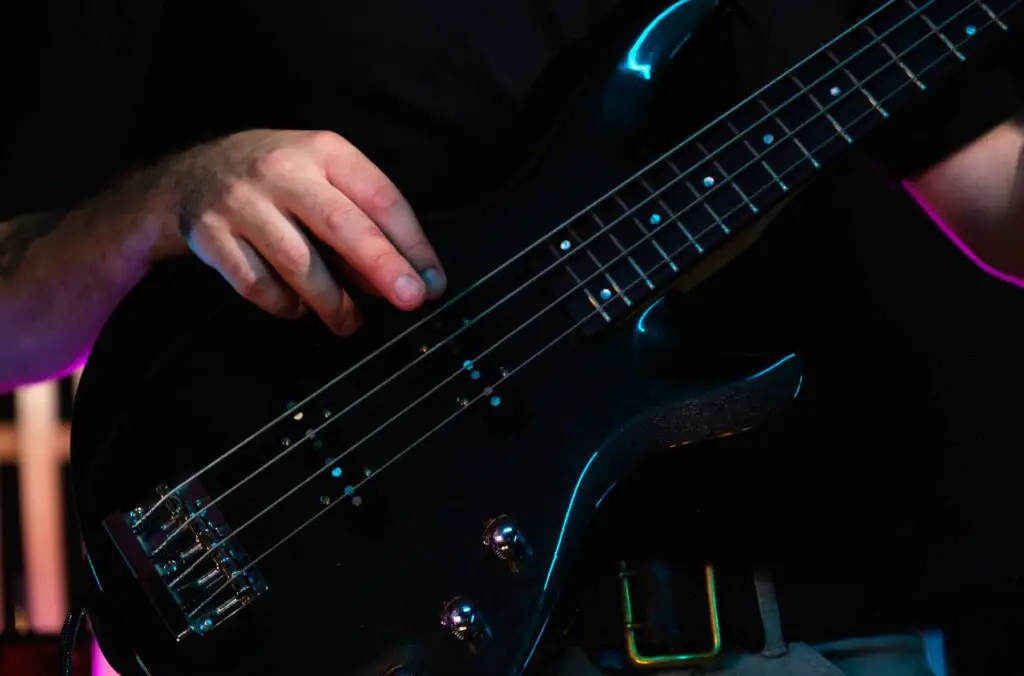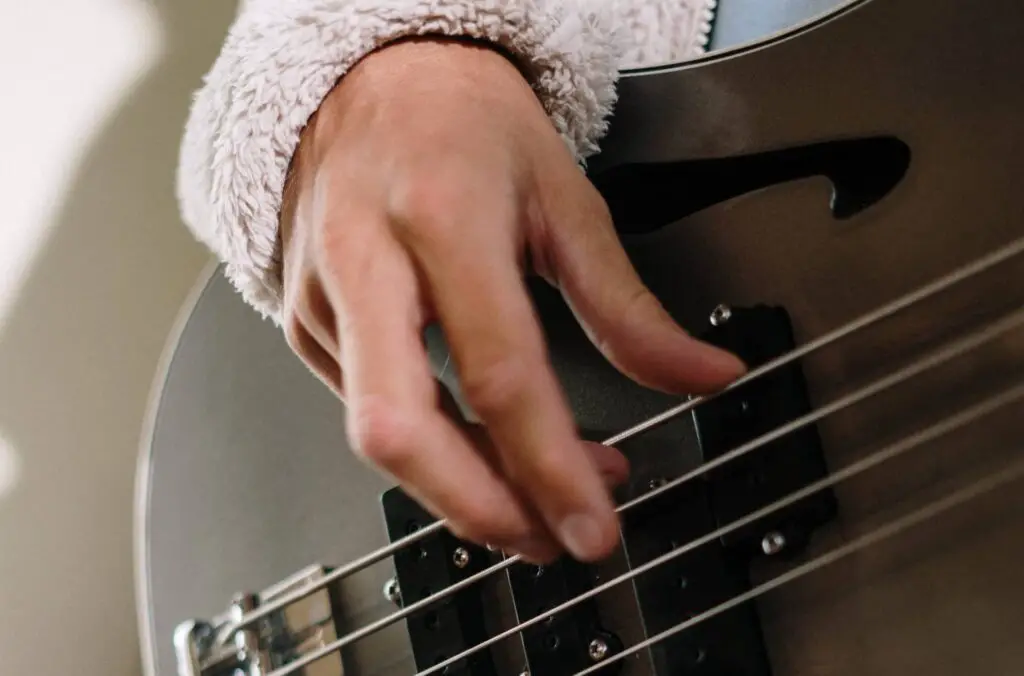As a bassist, there will come a point in time when you feel that your tone isn’t clean enough. It has happened to me, and it has happened to most bassists I know. Learning how to get a clean bass tone is rarely done overnight, but there are some things you can do that will immediately make your bass tone cleaner.
The cleanness of your bass tone depends on your bass setup, EQ, and technique. Proper muting and hand movement will make your tone cleaner and are skills that need to be developed over time. For immediate solutions, turning down the high frequencies and lowering your action will help in cleaning up your tone.
Furthermore, when bassists say that their tone isn’t clean enough, they often mean different things. Thus, I recommend applying all of the 6 tips outlined below to see how they impact the cleanness of your tone. Some of them will help a little, while others will help you attain exactly the type of tone you are after.
1. Turn down the highs
Turning up the high frequencies on your bass and your amp can give your sound more bite, and make overtones more pronounced.
For this reason, many bassists like to have their highs turned up. However, if you are looking to sound as clean as possible when playing, turning the highs down will help you achieve this. This will lead to a tone where there is less going on, but the trade-off is that you get a cleaner tone.
Related reading: This Is What The Knobs On An Electric Bass do
You do however want to find a middle ground with how much of the highs you’re going to cut. I find that removing them completely leads to a very sterile sound. Thus, aim for a middle ground where your tone sounds clean, while still retaining some highs.
2. Slow down
I have seen hundreds of bassists who think they can play fast. They hit every note on time at a fast tempo, which on the surface can seem like enough.
In reality, it is far from that simple. Thus, if you are playing fast basslines and can hear that your playing isn’t clean enough, consider it a good sign.
The best course of action then is to slow the bassline down. 60BPM tends to be a good starting spot. You can go even slower if the song is already at a slow tempo.
Practice the bassline at this tempo until you can play it cleanly, and incorporate the other tips in this article. Only increase the speed once your playing sounds clean enough to you.
Related reading: This Is How long you should practice bass each day
This doesn’t only have to do with tempo, but your posture and relaxation. You should never tense up when playing. Whether you are conscious of it or not, your tension will always be reflected in our tone.
Thus, notice how your shoulders feel relaxed when playing at slower tempos. As you increase the speed, keep maintaining that relaxed posture, and do not increase the speed until you can do so.

3. Lower the action
When listening back to your playing, you might hear unwanted fretting noise. It sounds like the string is being hit rather than held down, and the noise is audible enough to make your overall tone sound unclean.
If this is the case, you should consider lowering the action on your bass. This way, there will be less space between the strings and the frets. As a result, the strings will not be as audible when fretting them,
Bear in mind that how much you can lower the action on your bass varies. In general, how low you can go correlates with the overall quality of your instrument.
Furthermore, adjusting your action too low will result in unwanted fret buzz. This happens when there is too little space between the strings and the frets. If you can lower the action somewhat without there being an audible fret buzz, your fretting will sound cleaner, and your playing will sound more fluid overall.
4. Lighter plucking
How you pluck your strings will impact the cleanness of your tone. Aggressive plucking can give your playing a lot of character and is necessary for achieving a Geddy Lee-type sound. However, plucking the strings in a lighter fashion will make your tone sound cleaner and more controlled.
Do not make the mistake of trying to play as softly as you possibly can though. Rather, experiment with plucking the strings in a lighter fashion and see if you are able to find a technique that works for you. Remember that you still need to be able to pluck the strings consistently, at faster tempos, while sounding good
Chances are good that you will be able to play a little bit lighter after some experimenting and practice, but do not go overboard.
Furthermore, alternative tunings like A standard sound incredibly clanky with a regular set of bass strings. If your strings feel sloppy and have a clicky sound to them, lighter plucking will alleviate this somewhat. However, your strings are also in all likelihood too heavy and should be switched for a lighter set if this is the case.
5. Avoid unnecesary movement
I have seen many instances of bassists moving their hands around too much, and not being aware that they are doing so. The issue with this is that your fretting hand can produce a lot of unwanted sounds when you move it around.
Unnecessary movement can lead to multiple types of noise. It can lead to a scratching sound when moving fingers across strings unintentionally. It can also make it harder for you to keep strings muted, and make it harder to be precise and fluid in your playing overall.
You also want to use separate fingers when switching between notes whenever you can. Using the same finger when switching from one note to another on the same string will create a sliding effect. This effect has its uses, but when it’s done unintended, it will almost always make your playing sound worse.

6. Mute properly
Poor muting is by far the most common error that causes bassists to have a messy tone. Having unwanted strings ring out will even make people who claim to not be able to hear the bass notice that something is wrong.
How you keep your strings muted largely comes down to preference, and there are many ways to go about it. As a fingerstyle player, I always keep the thumb of my plucking hand on the highest unplayed string.
I also lean my thumb against deeper unplayed strings. I might for example play 8th notes on the D string, rest my thumb on the A-string while learning it on the E-string. This keeps both the A and E-strings muted.
The index finger on my fretting hand also rests on higher unplayed strings whenever possible. For example, if I`m playing at the 2nd fret on the A string, my index finger will rest on top of the 2nd fret of the D and G-strings as well, without fretting them.
This way, the plucking hand is muting unplayed deeper strings, and the fretting hand is muting unplayed higher strings. A similar technique can be used if you are playing with a pick, where you use the side of your thumb or your palm to mute strings.
Related reading: Is playing bass with a pick bad? (compared to fingerstyle)
Studybass.com has a great exercise that you can use to test your muting skills. For beginners, I recommend starting on exercise 1 and progressing upwards. If you are an intermediate bassist and feel like you have good control of your muting, try exercises 5 and 6. You can find the exercise here.
Conclusion
Knowing how to play clean as a bassist is important regardless of your skill level and genre. However, a noisy tone is oftentimes less of a problem than it might seem when playing with a band.
While the tips above will show you how to get a clean bass tone, a lot of the unwanted noise in your tone will be drowned out in a mix anyway. Thus, if your end goal is to have a clean tone when playing with others, you should focus more on how your bass sounds with other instruments, rather than on its own.
This is not to say that the cleanness of your tone doesn’t matter, far from it. It simply means that we perceive bass tone differently in isolation, which will often lead to us feeling that our tone isn’t clean enough when this isn’t the case.
Thus, when applying the tips above be mindful of both how they impact your tone individually, as well as the overall sound of your band.
The most noticeable difference between a beginner-level bassist and an intermediate bass player is how clean they sound. This is a direct result of all the skills that an intermediate bassist will have mastered. To learn more about the difference between beginner-level and intermediate bassists, continue by reading this article: What Makes A Bassist Intermediate?

